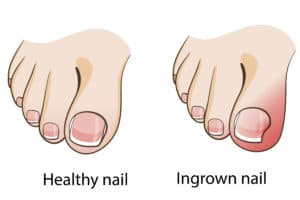
Blog, Ingrown Nails

Blog, Uncategorized

Ingrown toenail surgery—is it right for you?
What does ingrown toenail surgery involve?
Surgery to address an ingrown toenail (onychocryptosis) involves removing the bothersome nail and applying a chemical to prevent the nail from growing back.
In some instances it may be necessary or most beneficial to remove a small section of nail at one or both sides, but on the odd occasion the entire nail (total nail avulsion) will be removed.
It is a quick and simple procedure than is essentially pain free as it is performed with an injection of local anaesthetic.
Following surgery the toe is dressed and generally speaking there is little, if any, pain or discomfort. You may expect some throbbing that night or discomfort but this is most often managed well with paracetamol.
When is toenail surgery the best option?
Ingrown toenail surgery should not be considered first-line treatment for an ingrown toenail. It can be considered when:
- Other non-surgical methods have been exhausted
- The nail is involuted or curved
- Ingrown toenail is problematic, painful or recurring
- You understand the implications and potential complication of surgery
- You have discussed any concerns with your podiatrist
What are the advantages of clinic-based toenail surgery?
- No time in hospital
- No Sutures / stitches required – all completed under the nail plate
- No more recurrent ingrown toenails
- Pain free
- Minimal time off work
- Reduced episodes of infection and lesions (weeping, bleeding)
- In the majority of cases, ingrown toenail surgery is very successful
Dr Brenden Brown, podiatrist and founder of A Step Ahead Foot + Ankle Care, says, “Nail surgeries are not new for podiatrists; we perform them on a regular basis. It is part of our training at University so we are well versed in this surgery. It is carried out in our clinic and, due to our high level of training, is a fairly simple procedure.
“I often describe this surgery as ‘relatively pain free’. It is wrong to say any surgical procedure is ‘completely pain free’ but as procedures go our patients report very little, if any, pain. In fact, patients are frequently surprised at just how pain free it actually is!
“This procedure can certainly be of benefit and is recommended for patients who have a history of infection or recurrent ingrown toenails. It’s also very helpful for patients with involuted or very curved nails and toenails with areas that seem to catch the skin on the side of the nail.
“Patients often suffer from an ingrown toenail for many years with little idea where to go to for help.
“The days of painful surgeries with patients regularly experience nail re-growth are gone. It’s also important to remember that what you see on YouTube and other social media sites is often the ‘most horrible’ and ‘most atrocious’. If it wasn’t so gruesome you probably wouldn’t have been so motivated to watch and it likely would have got the “views” it did!
Related articles:
5 hacks to keep ingrown toenails at bay
ABOUT US
A Step Ahead Foot + Ankle Care is one of Sydney’s leading foot and ankle clinics. Principal podiatrist and founder of A Step Ahead Dr Brenden Brown (AKA Dr Foot) has been taking care of people’s feet for more than 20 years.
With a background in sports medicine and having served as a former president of the Australasian Podiatry Council, Brenden is a wealth of information when it comes to foot and ankle care.
Got a question? Check out our Instagram profile #AskDrFoot
Tune into our Facebook page for regular live videos and updates on the latest foot and ankle advice from the experts.

Blog, Uncategorized

5 hacks to keep ingrown toenails at bay
What causes an ingrown toenail?
Ingrown toenail (known medically as onychocryptosis) is a condition where the edge of the toenail (most commonly on the big toe) pierces or catches on the skin as it grows up.
MYTH: Nails only grow upwards they do not on any occasion grow outwards towards the side.
There are several causes of an ingrown toenail but probably the most widespread is poor toenail-trimming technique. Cutting down the side of the nail is a major no-no. Why? Because even the smallest spike of nail can grow up and penetrate, or get caught on, the skin.
The ingrown slither of nail acts like a splinter; the skin around it thinks it’s a foreign body and becomes inflamed and infected.

5 hacks to prevent ingrown toenails
- Clip with caution. Trim toenails straight across. DO NOT cut down the sides of the nail and refrain from cutting nails too short
- Refrain from ripping the nails down the sides. We have all done this! You cut but you can’t get that last bit of nail, so you abandon the clippers and rip the last piece down the side. This leaves a sharp spike, which may not be painful now but in following days it will grow upwards and catch on the skin piercing it creating the subsequent infection and PAIN!
- Ditch footwear that is too tight or constricts the toes from moving. This can push the nail into the skin causing irritation and infection
- Steer clear of unqualified people offering to remove ingrown toenails. While this may sound somewhat self-serving, there are an increasing number of nail salons offering to perform this sort of work. Removing the nail breaks the skin barrier, which can easily become infected. Whilst your podiatrist makes it look easy that is because it’s what they have been trained to do and complete on a regular basis.
- Adhere to best-practice foot care by keeping feet clean and dry to avoid weak, splitting nail and fungal infections.
How to fix ingrown toenails — at home
To treat an ingrown toenail at home you can try: Cutting the nails straight across and applying an antibiotic cream to help reduce the risk of infection and subsequent inflammation. You can also use a nail file to round the corners!
MYTH: Cutting a V in your toenail will not make it grow inwards; nails only grow upwards. While the V may look like it’s closing in, this is an illusion as you are trimming the top of the V, making it appear like the V is getting smaller over time.
Applying a small piece of cotton wool between the ingrown nail and the skin can help life the nail, hopefully clearing it and preventing the nail from piercing the skin again.
Avoid wearing high heels, pointed or tight fitting shoes as these can place pressure on the affected area, potentially delaying healing.
The professional approach
Dr Brenden Brown, podiatrist and founder of A Step Ahead Foot + Ankle Care, says, “If the toenail turns into a monster and becomes red, angry or infected—It’s definitely time to seek professional advice.
“A podiatrist can easily treat an ingrown toenail by removing the troublesome spike of nail. In most cases this is a quick (takes minutes) and simple procedure, which is completely painless.
“Following the removal of the nail spile, the toenail area is cleaned and, if infection has been present, the toe will be dressed.
“In extreme cases, toenail surgery may be required. This will generally only happen if the patient has a repeated history of recurrent in grown nails or if the nails shape means it requires removal of that section, such as when it is involuted or excessively curved.
“It is more rare than most people think to remove a whole nail as we can manage these well conservatively”
Related articles:
Ingrown toenail surgery—is it right for you?
ABOUT US
A Step Ahead Foot + Ankle Care is one of Sydney’s leading foot and ankle clinics. Principal podiatrist and founder of A Step Ahead Dr Brenden Brown (AKA Dr Foot) has been taking care of people’s feet for more than 20 years.
With a background in sports medicine and having served as a former president of the Australasian Podiatry Council, Brenden is a wealth of information when it comes to foot and ankle care.
Got a question? Check out our Instagram profile #AskDrFoot
Tune into our Facebook page for regular live videos and updates on the latest foot and ankle advice from the experts.

Blog

Your guide to rock-solid ankle stability
Your feet and ankles are the foundation of your body so imagine the persistent feeling that your ankle is going to “give away” or actually having your ankle collapse under the weight of your body? Ouch!
Sports podiatrist and founder of A Step Ahead Foot + Ankle Care Dr Brenden Brown explains, “Ankle instability is that uneasy feeling that your ankle is going to roll out, particularly when walking or running on rough surfaces.
“We tend to think of these ‘rough’ surfaces as being a rocky terrain or very unsteady ground but for someone who has had a previous ankle sprain, a rough surface can simply be a bump in a soccer field.”

So what are some key points about ankle instability?
- Having an ankle sprain increases the chance of another ankle sprain
- Those people who have an ankle sprain but don’t undergo physical therapy and rehabilitation are significantly more likely to re-sprain
- Repeated spraining or injury to the ankle can lead to chronic ankle instability (this can seriously effect quality of life)
- In fact, 33% of people with first time ankle sprains go on to develop chronic ankle instability.
- You can’t cure ankle instability by doing nothing. Evidence suggests it’s very unlikely it will get better by itself.
- Stopping exercise or playing sports won’t alleviate ankle instability but could cause other negative health impacts.
While many people underestimate the impact of ankle instability and simply don’t pay their ankles the attention they deserve, other causes include hyper-mobility (being double jointed), a very high foot arch and weak muscular control in a single leg.
Treating ankle instability
“When it comes to treatment, it’s important to note that it’s not just about the ankle – you need to consider the whole limb,” says Dr Brenden.
“Unfortunately, there’s also the common misconception amongst many health professionals that a single style of treatment will make ALL ankle sprains better. This isn’t so; treatment should be tailored to the type of sprain.
“Similarly, there’s the misunderstanding that wearing an ankle brace or taping the ankle will prevent ankle instability. Not so.
“We’re finding that the entire leg, in particular the glutes and all the muscles above the ankle are more vital than we ever thought before.
“If you have weak glutes or poor hip function on your left hand side you’re significantly more likely to twist your left ankle.”
Aside from just focusing on the ankle itself, Dr Brenden says there’s a growing body of evidence to support strength work through exercise.
This involves firstly identifying where the muscle imbalance is coming from and then performing targeted strength exercises.
“I have a real problem with healthcare practitioners who only ever tell people with ankle instability to do calf raises. If you’re a tennis player, calf raises are inappropriate because you’re jumping side to side rather than raising the feet up and down.
“Rehabilitation exercises need to be specific to the sport you play. You can’t take a ‘one-size-fits-all’ approach.”
Other methods of treatment include:
Footwear— A firm base and firm heel counter (we’re talking good quality trainers) is important while the ankle is unstable.
Orthotics—There’s a sound body of evidence that suggests looking at foot posture can be helpful. Over use of the muscles can affect the way the foot moves and, if left untreated, this can lead to ankle instability.
“The vast problem is that people delay treatment and end up having multiple ankle sprains, which not only damages the anterior talofibular ligament (ATFL) but the surrounding muscles as well.”
Ultimately, poor ankle stability can lead to a chain reaction of injury so it’s important to talk to your local podiatrist to find out the best method of action.
A Step Ahead Foot + Ankle Care is one of Sydney’s leading foot and ankle clinics. Principal podiatrist and founder of A Step Ahead Dr Brenden Brown (AKA Dr Foot) has been taking care of people’s feet for more than 20 years. With a background in sports medicine and having served as a former president of the Australasian Podiatry Council, Brenden is a wealth of information when it comes to foot and ankle care.
Find out more about ankle sprains and how to treat them
Got a question? Check out our Instagram profile #AskDrFoot
Or simply tune into our Facebook page for regular live videos and updates on the latest foot and ankle advice from the experts.

Blog

How to treat and prevent fungal nail infections
Fungal nail infection (also called onychomycosis) is responsible for approximately 50% of all nail disease and in western countries it appears to be on the rise* due to our ageing populations and lifestyle changes.
If you suspect you have a fungal nail infection there are many treatments available—although success rates vary greatly.
Treating fungal nail
“Typically fungal nail infection won’t go away without treatment; this can include over-the-counter topical antifungal creams and ointments, prescribed oral antifungal pills, laser treatment, or, in severe cases, surgical nail removal,” says Dr Brenden, principle podiatrist and owner at A Step Ahead Foot + Ankle Care.
“The biggest problem with topical antifungal agents is that they’re often ineffective, while oral terbinafine—despite being considered a ‘first-line’ treatment—requires strict adherence for 12 weeks.”
In recent years laser technology has emerged as an effective method of treating fungal nail infections. Performed by your local podiatrist, laser allows light to pass through the nail into the nail bed, effectively treating the infection at its source.
The heat from the laser kills both fungi and spores. Providing every nail is treated (which is what we recommend), the likelihood of success is high.
Preventing fungal nail from striking
“Fungal nail infection is much like a tummy bug; it can be passed on to others you come into contact with, particularly family members. As such, it really does pay to know how to protect against fungal infection,” says Dr Brenden (A.k.a Dr Foot)
The following steps can help keep your feet and nails fungus free:
- Avoid public showers. If you must use a community shower—wear thongs
- Boil your socks. Fungi thrive in warm, moist environment (Hello sports socks!) but they can’t survive extremely high temperatures. Boil your socks regularly, for at least 10 minutes, to kill off any hidden fungi spores.
- Keep feet clean and dry. In between sweaty toes is the ideal habitat for infuriating fungi. Stop fungal infection for striking by keeping feet clean and dry. If you’re prone to sweaty feet, try an antifungal foot powder, spray the soles of your feet with antiperspirant and don’t forget to change your socks daily.
- Don’t share nail clippers. Sharing is caring but not when it comes to fungal nail infection. Be vigilant at the nail salon; ensure the nail tools they use have been sterilised.
Next steps…
We treat several people a day for fungal nail infections. If we can help you please let us know! You can contact us through our helpful front desk team. They speak to multiple patients a day with this condition. They can run you through our process and costings and reserve an appointment time that suits you best. Our number is +61 2 9673 2987 we would LOVE to help.
Medical clinics + other podiatry clinics
If you are one of the many Podiatry / Medical clinics that follow my posts please read the details in my clinic websites, I am currently developing a course for practitioners interested in learning more effective and efficient ways of treating nail fungus. If you follow our posts we will announce this as it occurs or simply send us a message and our office will save your details. We look forward to helping you as well! Our number is 02 9673 2987. Hope to chat soon.
Want to know more about fungal nail infection?
Check out fungalnaildoctor.com.au
See what Dr Brenden has to say on the topic of fungal nails and laser therapy via his Facebook Live session
Clue up on our top 5 tips for fungus-free feet
Discover how Tanya beat fungal nail infection
* Thomas J, et al. Toenail onychomycosis: an important global disease burden. J Clin Pharm Ther 2010;35(5):497-519.



 Founder of A Step Ahead Foot + Ankle Care in Sydney, and former president of the Australasian Podiatry Council, Dr Brenden Brown (A.K.A Dr Foot) is a wealth of knowledge on how to take care of your feet, including how to find the best shoes.
Founder of A Step Ahead Foot + Ankle Care in Sydney, and former president of the Australasian Podiatry Council, Dr Brenden Brown (A.K.A Dr Foot) is a wealth of knowledge on how to take care of your feet, including how to find the best shoes.













 Dr Brenden’s White paper report on the “6 Reasons You Won’t Beat Heal Pain” outlines what’s stopping you from beating this and tips on how to stop it in its tracks!
Dr Brenden’s White paper report on the “6 Reasons You Won’t Beat Heal Pain” outlines what’s stopping you from beating this and tips on how to stop it in its tracks!